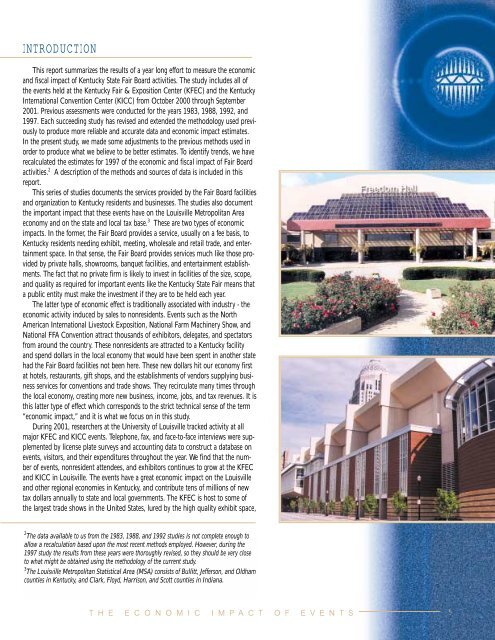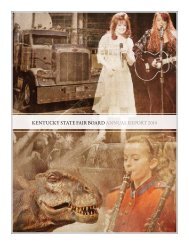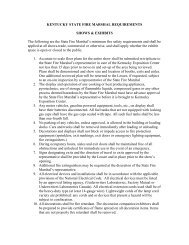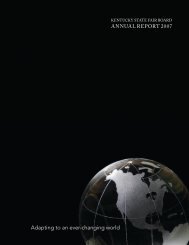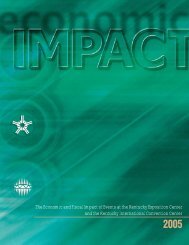2001 Economic Impact Study of the Kentucky State Fair Board
2001 Economic Impact Study of the Kentucky State Fair Board
2001 Economic Impact Study of the Kentucky State Fair Board
You also want an ePaper? Increase the reach of your titles
YUMPU automatically turns print PDFs into web optimized ePapers that Google loves.
INTRODUCTION<br />
This report summarizes <strong>the</strong> results <strong>of</strong> a year long effort to measure <strong>the</strong> economic<br />
and fiscal impact <strong>of</strong> <strong>Kentucky</strong> <strong>State</strong> <strong>Fair</strong> <strong>Board</strong> activities. The study includes all <strong>of</strong><br />
<strong>the</strong> events held at <strong>the</strong> <strong>Kentucky</strong> <strong>Fair</strong> & Exposition Center (KFEC) and <strong>the</strong> <strong>Kentucky</strong><br />
International Convention Center (KICC) from October 2000 through September<br />
<strong>2001</strong>. Previous assessments were conducted for <strong>the</strong> years 1983, 1988, 1992, and<br />
1997. Each succeeding study has revised and extended <strong>the</strong> methodology used previously<br />
to produce more reliable and accurate data and economic impact estimates.<br />
In <strong>the</strong> present study, we made some adjustments to <strong>the</strong> previous methods used in<br />
order to produce what we believe to be better estimates. To identify trends, we have<br />
recalculated <strong>the</strong> estimates for 1997 <strong>of</strong> <strong>the</strong> economic and fiscal impact <strong>of</strong> <strong>Fair</strong> <strong>Board</strong><br />
activities. 2 A description <strong>of</strong> <strong>the</strong> methods and sources <strong>of</strong> data is included in this<br />
report.<br />
This series <strong>of</strong> studies documents <strong>the</strong> services provided by <strong>the</strong> <strong>Fair</strong> <strong>Board</strong> facilities<br />
and organization to <strong>Kentucky</strong> residents and businesses. The studies also document<br />
<strong>the</strong> important impact that <strong>the</strong>se events have on <strong>the</strong> Louisville Metropolitan Area<br />
economy and on <strong>the</strong> state and local tax base. 3 These are two types <strong>of</strong> economic<br />
impacts. In <strong>the</strong> former, <strong>the</strong> <strong>Fair</strong> <strong>Board</strong> provides a service, usually on a fee basis, to<br />
<strong>Kentucky</strong> residents needing exhibit, meeting, wholesale and retail trade, and entertainment<br />
space. In that sense, <strong>the</strong> <strong>Fair</strong> <strong>Board</strong> provides services much like those provided<br />
by private halls, showrooms, banquet facilities, and entertainment establishments.<br />
The fact that no private firm is likely to invest in facilities <strong>of</strong> <strong>the</strong> size, scope,<br />
and quality as required for important events like <strong>the</strong> <strong>Kentucky</strong> <strong>State</strong> <strong>Fair</strong> means that<br />
a public entity must make <strong>the</strong> investment if <strong>the</strong>y are to be held each year.<br />
The latter type <strong>of</strong> economic effect is traditionally associated with industry - <strong>the</strong><br />
economic activity induced by sales to nonresidents. Events such as <strong>the</strong> North<br />
American International Livestock Exposition, National Farm Machinery Show, and<br />
National FFA Convention attract thousands <strong>of</strong> exhibitors, delegates, and spectators<br />
from around <strong>the</strong> country. These nonresidents are attracted to a <strong>Kentucky</strong> facility<br />
and spend dollars in <strong>the</strong> local economy that would have been spent in ano<strong>the</strong>r state<br />
had <strong>the</strong> <strong>Fair</strong> <strong>Board</strong> facilities not been here. These new dollars hit our economy first<br />
at hotels, restaurants, gift shops, and <strong>the</strong> establishments <strong>of</strong> vendors supplying business<br />
services for conventions and trade shows. They recirculate many times through<br />
<strong>the</strong> local economy, creating more new business, income, jobs, and tax revenues. It is<br />
this latter type <strong>of</strong> effect which corresponds to <strong>the</strong> strict technical sense <strong>of</strong> <strong>the</strong> term<br />
“economic impact,” and it is what we focus on in this study.<br />
During <strong>2001</strong>, researchers at <strong>the</strong> University <strong>of</strong> Louisville tracked activity at all<br />
major KFEC and KICC events. Telephone, fax, and face-to-face interviews were supplemented<br />
by license plate surveys and accounting data to construct a database on<br />
events, visitors, and <strong>the</strong>ir expenditures throughout <strong>the</strong> year. We find that <strong>the</strong> number<br />
<strong>of</strong> events, nonresident attendees, and exhibitors continues to grow at <strong>the</strong> KFEC<br />
and KICC in Louisville. The events have a great economic impact on <strong>the</strong> Louisville<br />
and o<strong>the</strong>r regional economies in <strong>Kentucky</strong>, and contribute tens <strong>of</strong> millions <strong>of</strong> new<br />
tax dollars annually to state and local governments. The KFEC is host to some <strong>of</strong><br />
<strong>the</strong> largest trade shows in <strong>the</strong> United <strong>State</strong>s, lured by <strong>the</strong> high quality exhibit space,<br />
2 The data available to us from <strong>the</strong> 1983, 1988, and 1992 studies is not complete enough to<br />
allow a recalculation based upon <strong>the</strong> most recent methods employed. However, during <strong>the</strong><br />
1997 study <strong>the</strong> results from <strong>the</strong>se years were thoroughly revised, so <strong>the</strong>y should be very close<br />
to what might be obtained using <strong>the</strong> methodology <strong>of</strong> <strong>the</strong> current study.<br />
3 The Louisville Metropolitan Statistical Area (MSA) consists <strong>of</strong> Bullitt, Jefferson, and Oldham<br />
counties in <strong>Kentucky</strong>, and Clark, Floyd, Harrison, and Scott counties in Indiana.<br />
T H E E C O N O M I C I M P A C T O F E V E N T S<br />
5


